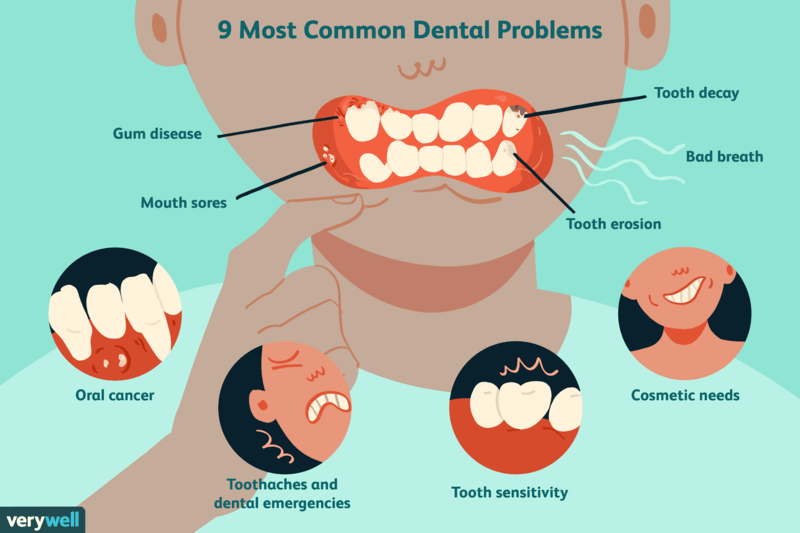
Hey there, folks! Let’s talk about something that affects all of us at some point in our lives: dental problems. Yep, those pesky issues that can make our teeth ache and our smiles fade. But fear not, because today we’re going to dive into the world of common dental problems and how to treat them. So, grab your toothbrush and get ready for some valuable insights!
When it comes to dental problems, there are a few that tend to pop up more often than others. From tooth decay to gum disease, these issues can really put a damper on our oral health. But fret not, my friends, because there are ways to tackle these problems head-on. Whether it’s practicing good oral hygiene, visiting your friendly neighborhood dentist, or making some lifestyle changes, we’ve got you covered. So, let’s explore the ins and outs of these common dental problems and discover the best ways to treat them. Get ready to flash those pearly whites with confidence again! Now, let’s get started, shall we?
Common Dental Problems and How to Treat Them
When it comes to dental health, there are a few common problems that many people face. Tooth decay, gum disease, and tooth sensitivity are some of the most common issues. To treat tooth decay, your dentist may recommend a filling or a dental crown. Gum disease can be treated with professional cleaning, scaling, and root planing. For tooth sensitivity, using a desensitizing toothpaste or getting a fluoride treatment can help. Remember to maintain good oral hygiene practices, such as brushing and flossing regularly, to prevent these problems.
:max_bytes(150000):strip_icc()/top-common-dental-problems-1059461_color1-5c1afdd346e0fb0001efc715.png)
Common Dental Problems and How to Treat Them
Dental problems are a common occurrence for many people, and knowing how to treat them is essential for maintaining good oral health. From cavities to gum disease, there are several issues that can arise, causing discomfort and potential long-term damage if left untreated. In this article, we will explore some of the most common dental problems and discuss effective treatment options.
Tooth Decay and Cavities
Tooth decay and cavities are among the most prevalent dental problems worldwide.
They occur when bacteria in the mouth produce acids that erode the enamel, resulting in small holes in the teeth known as cavities. Without treatment, cavities can deepen and cause toothaches, infections, and even tooth loss.
The treatment for tooth decay and cavities typically involves removing the decayed portion of the tooth and filling the cavity with a dental filling material, such as composite resin or amalgam. In more severe cases, a dental crown may be necessary to restore the tooth’s structure and function.
Preventive measures, such as regular brushing and flossing, as well as routine dental check-ups, can help prevent cavities from developing in the first place.
Gum Disease
Gum disease, also known as periodontal disease, is an infection of the gums and tissues that support the teeth. It is caused by the buildup of plaque, a sticky film of bacteria, on the teeth and gums. If left untreated, gum disease can lead to gum inflammation, gum recession, tooth loss, and even systemic health problems.
The treatment for gum disease depends on the severity of the condition.
In the early stages, known as gingivitis, professional cleaning and improved oral hygiene practices, such as regular brushing, flossing, and using antibacterial mouthwash, can help reverse the disease. In more advanced cases, scaling and root planing, gum surgery, or other periodontal procedures may be necessary to remove plaque and bacteria from below the gumline and restore gum health.
Orthodontic Issues
Orthodontic issues refer to problems with the alignment of the teeth and jaws. Common orthodontic issues include crooked teeth, overcrowding, overbite, underbite, and crossbite. These issues can not only affect the appearance of the smile but also lead to difficulties with chewing, speaking, and maintaining oral hygiene.
The treatment for orthodontic issues varies depending on the specific problem. Traditional braces, clear aligners, and other orthodontic appliances are commonly used to gradually move the teeth into their proper positions. In some cases, orthodontic treatment may be combined with other dental procedures, such as tooth extraction or jaw surgery, to achieve the desired results.
Missing Teeth
Missing teeth can have a significant impact on a person’s oral health and self-confidence. When a tooth is lost, the surrounding teeth may shift, leading to bite problems and potential bone loss in the jaw. Additionally, missing teeth can affect speech and make it difficult to chew properly.
The treatment options for missing teeth include dental implants, bridges, and dentures. Dental implants are considered the gold standard for tooth replacement as they provide a permanent solution that looks and functions like natural teeth. Bridges and dentures are also viable options, depending on the number and location of the missing teeth.
Oral Infections
Oral infections, such as tooth abscesses and oral thrush, can cause significant discomfort and require prompt treatment. A tooth abscess is a pocket of pus that forms at the root of a tooth due to a bacterial infection. It often causes severe toothache, swelling, and sensitivity to hot and cold temperatures. Oral thrush, on the other hand, is a fungal infection that affects the mouth and throat, resulting in white patches, redness, and soreness.
The treatment for oral infections typically involves draining the abscess, prescribing antibiotics or antifungal medications, and addressing the underlying cause of the infection. In some cases, a root canal procedure may be necessary to save an abscessed tooth. Maintaining good oral hygiene and seeking prompt dental care can help prevent oral infections from occurring.
Conclusion
Understanding common dental problems and their treatments is essential for maintaining optimal oral health. Whether it’s tooth decay, gum disease, orthodontic issues, missing teeth, or oral infections, seeking professional dental care and practicing good oral hygiene are key to preventing and addressing these problems effectively. Remember to schedule regular dental check-ups and follow the advice of your dentist to keep your smile healthy and beautiful.
Key Takeaways: Common Dental Problems and How to Treat Them
- Tooth decay can be prevented by brushing and flossing regularly.
- Gum disease can be treated with proper oral hygiene and professional dental cleanings.
- Tooth sensitivity can be managed by using desensitizing toothpaste and avoiding acidic foods.
- Cavities can be filled by a dentist to prevent further damage.
- Bad breath can be reduced by practicing good oral hygiene and avoiding certain foods.
Frequently Asked Questions
Here are some common questions about dental problems and their treatments:
1. What are the most common dental problems?
The most common dental problems include cavities, gum disease, tooth sensitivity, bad breath, and tooth loss. Cavities are caused by tooth decay and can result in tooth pain and sensitivity. Gum disease, also known as periodontal disease, occurs when the gums become inflamed and infected. Tooth sensitivity is characterized by pain or discomfort when consuming hot or cold foods and drinks. Bad breath, or halitosis, can be caused by poor oral hygiene or underlying dental issues. Tooth loss can occur due to decay, gum disease, or trauma.
Treating these dental problems often involves a combination of good oral hygiene practices, such as regular brushing and flossing, as well as professional dental treatments like fillings, deep cleanings, and dental implants.
2. How are cavities treated?
Cavities are typically treated by removing the decayed portion of the tooth and filling the space with a dental filling material. The dentist will first numb the area with a local anesthetic to ensure a comfortable procedure. Then, they will use a dental drill or laser to remove the decayed part of the tooth. Once the cavity is cleaned and prepared, the dentist will fill it with a filling material, such as composite resin or amalgam.
Regular dental check-ups are essential for detecting cavities early on and preventing further damage. Maintaining good oral hygiene, including brushing twice a day and flossing daily, can also help prevent cavities.
3. What are the treatment options for gum disease?
The treatment options for gum disease depend on the severity of the condition. For mild cases, a professional dental cleaning, known as scaling and root planing, may be sufficient. This procedure involves removing plaque and tartar from the teeth and smoothing the tooth roots to prevent further bacterial growth.
In more advanced cases, surgical interventions may be necessary. These can include gum grafts to replace lost gum tissue, flap surgery to lift and clean beneath the gums, or bone grafting to regenerate lost bone support. It is important to address gum disease promptly to prevent further damage to the gums and underlying structures.
4. How can tooth sensitivity be treated?
Tooth sensitivity can be treated in various ways. Using a desensitizing toothpaste can help block the transmission of pain signals from the tooth to the nerves. Fluoride treatments, either in-office or at home, can strengthen the enamel and reduce sensitivity. In some cases, dental sealants or bonding agents may be applied to cover exposed root surfaces and protect against sensitivity.
Identifying the underlying cause of tooth sensitivity is crucial for effective treatment. It may be due to tooth decay, gum recession, cracked teeth, or worn enamel. Consulting with a dentist will help determine the most appropriate treatment plan.
5. What are the treatment options for tooth loss?
There are several treatment options for tooth loss, including dental implants, bridges, and dentures. Dental implants are considered the gold standard for tooth replacement as they provide a permanent and natural-looking solution. The implant is surgically placed into the jawbone and acts as a replacement for the tooth root. A custom-made crown is then attached to the implant to complete the restoration.
Bridges are used to fill the gap left by one or more missing teeth. They consist of artificial teeth that are anchored to the adjacent natural teeth or dental implants. Dentures, both full and partial, are removable appliances that replace multiple missing teeth. They are custom-made to fit the individual’s mouth and restore their ability to chew and speak properly.
5 Common Dental Problems in Children | DENTAL HEALTH IN CHILDREN – Dr. K Saranya | Doctors’ Circle
Final Thoughts
And there you have it, a comprehensive guide to common dental problems and how to treat them. We’ve covered everything from cavities to gum disease, tooth sensitivity to bad breath, and provided you with practical tips and advice to maintain a healthy smile. Remember, prevention is key, so make sure to practice good oral hygiene, visit your dentist regularly, and watch out for any signs of trouble.
By being proactive and taking care of your teeth, you can avoid many of these common dental problems and enjoy a lifetime of healthy smiles. Don’t let fear or neglect hold you back from achieving optimal dental health. Take the necessary steps to address any issues and seek professional help when needed. Your smile is worth it!
Call or Book appointment online
:Ace Dental Care Alpharetta office: 678-562-1555 - Book Now
Ace Dental Care Norcross office: 770-806-1255 - Book Now
Disclaimer
This blog post was generated by artificial intelligence. The content of this post may not be accurate or complete, and should not be relied upon as a substitute for professional advice. If you have any questions about the content of this post, please contact us.
We are constantly working to improve the accuracy and quality of our AI-generated content. However, there may still be errors or inaccuracies. We apologize for any inconvenience this may cause.





